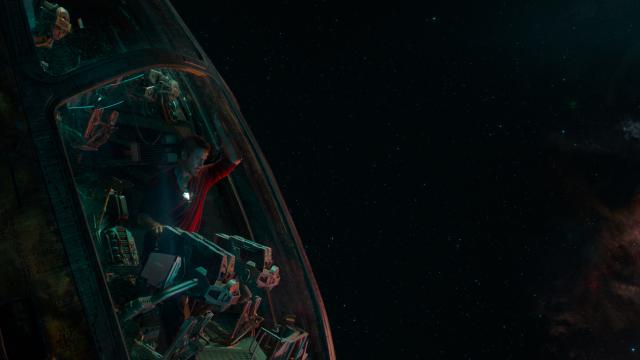Avengers: Endgame is the rare kind of film whose three-hour, intermission-less runtime is a price audiences are willing to pay without batting an eye because, as Marvel Studios keeps reminding everyone, this is the end of an era. A narrative climax of Endgame’s proportions rightfully deserves to take its time. But people also deserve to stretch.
According to the Russo Brothers, out of the first four cuts of Endgame that were screened for the public, people only felt the need to leave their seats for whatever reason during the very first showing, and everyone stayed put during the subsequent three. The filmmakers are confident that they’ve gotten Endgame to a point where, while long, it’s bearably so, and the assumption is that people will go into theatres knowing what they’ve signed up for and understanding they need to have a plan.
Small bladder? Go to the bathroom before, and pace your soda intake during the movie. Big snacker? Stock up before you sit down. Prone to getting leg cramps? Tough luck; take up yoga, or go to a fancier theatre.
Three-hour movies are common enough that moviegoing audiences know how to handle them, and the vast majority of people will be able to sit through Endgame without interruption just fine. But consider for a moment what an Endgame screening might be like with a built-in intermission. An intermission, not just for people to address whatever bodily needs they might have, but one also meant to be an important part of the larger theatergoing experience.
[referenced url=”https://gizmodo.com.au/2019/03/sure-seems-like-avengers-endgameis-3-hours-long/” thumb=”https://i.kinja-img.com/gawker-media/image/upload/t_ku-large/xca2zdkbk2gkxxn4vggl.png” title=”Sure Seems Like Avengers: Endgame Is 3 Hours Long” excerpt=”Hold on to your butts. Whatever it takes.”]
In the early days of cinema, intermissions were a practical necessity because the film reels simply could not hold entire movies. You got to the end of one reel, popped it out, and popped in the next one to keep things rolling. Coincidentally, this was also the case with a number of long films’ VHS releases. Intermissions gave people a chance to get up, stretch their legs, and, much to theatre owners’ delight, come and buy more concessions than they wouldn’t have otherwise. But intermissions predate film by hundreds of years, and it’s those roots in the theatre where the argument for having one during Avengers: Endgame lies.
Before retiring in 2016, Patrice Pavis was the Professor for Theatre Studies at the University of Kent in Canterbury, and in 1987 he published his Dictionnaire du Theatre (translated by Christine Shantz), an encyclopedic index of theatre terminology and deeper theory associated with the terms. While intermissions served the obvious purpose of giving actors time to change sets on stage, Pavis explains that there was an important social function to them as well. For one, it gave theatergoers a chance to see and speak to one another at what was meant to be a social event.
But more importantly, Pavis argued that intermissions were a “psychological necessity” because of the way they push audiences to briefly reconnect with reality before diving back into the fantasy:
The return to reality invites the spectators, like it or now, to think about what they have just seen, to judge the work, to put together their impressions in a structured way. The intermission signals an awakening of the critical faculties, and it is not surprising that epic dramaturgy favours many such pauses, forcing the audience to intervene in these moments of “dis-illusion.” Productions that are based on fascination have their own specific rhythm, on the other hand, often do away with these precious minutes of respite.
Riveted to his place, mute, his back aching from seats designed with no consideration for human anatomy, the present-day spectator cannot even express his bad temper—he is compelled to take part in the religious ceremony of ‘mass-en-scène’ and not break the continuity of the performance. In this test of endurance, it is a coup to prevent the ‘brain-drain’ of the spectators from the theatre space.
Of course, Pavis is musing about going to the Theatre™ to see live performances in productions where, no matter how excellent the sets and practical effects, it’s necessary for the audience to suspend disbelief in order to truly lose themselves in the story being told. We don’t have to watch Bradley Cooper traipse his way across a stage in a raccoon costume, or play along when Captain Marvel going full Binary is signalled with a barrage of flashing lights overhead.
But his points about the theatre as a social experience and audiences needing to engage with and process the story they are witnessing are well-made, and particularly applicable to something like Avengers: Endgame. It’s a given that people want to talk about all of Marvel’s movies (and folks often do during the films) but, at least on its face, Endgame’s going to be a bit different because of the sheer scale of it.
Even though half of the universe has been wiped out, Endgame’s lead cast is still incredibly large, between the remaining Avengers, Okoye, Nebula, Captain Marvel, War Machine, and Rocket. Over the course of the film, they’ve all got to come together, figure out a plan, find Thanos, and (presumably) whoop him, all while laying the narrative groundwork for the next phase of the MCU. It’s safe to bet there will be at least a couple big CGI fights, and of course there’s the whole business of people (presumably) coming back from the dead and having tearful reunions with their loved ones.
Endgame is going to be a big movie. A dense movie. It’s a movie that people want to be able to see without worrying if they’re going to wet themselves. More than any of that, though, it’s a movie that we’ve all been waiting to pore over and properly understand. Folks are going to do that either way, but it’s something that could be done much more easily if the film had an intermission.
Avengers: Endgame drops April 24.
